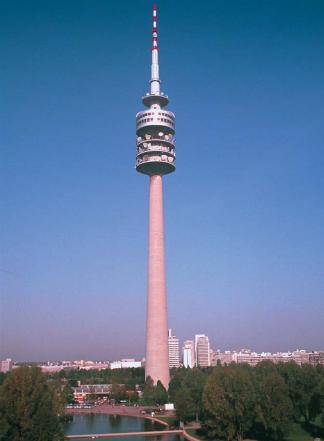Microwave communication

A microwave is an electromagnetic wave with a very short wavelength, between .039 inches (1 millimeter) and 1 foot (30 centimeters). Within the electromagnetic spectrum, microwaves can be found between radio waves and shorter infrared waves. Their short wavelengths make microwaves ideal for use in radio and television broadcasting. They can transmit along a vast range of frequencies without causing signal interference or overlap.
Microwave technology was developed during World War II (1939–45) in connection with secret military radar research. Today, microwaves are used primarily in microwave ovens and communications. A microwave communications circuit can transmit any type of information as efficiently as telephone wires.
The most popular devices for generating microwaves are magnetrons and klystrons. They produce microwaves of low power and require the use of an amplification device, such as a maser (microwave amplification by stimulated emission of radiation). Like radio waves, microwaves can be modulated for communication purposes. However, they offer 100 times more useful frequencies than radio.
Microwaves can be easily broadcast and received via aerial antennas. Unlike radio waves, microwave signals can be focused by antennas just as a searchlight concentrates light into a narrow beam. Signals are transmitted directly from a source to a receiver site. Reliable microwave signal range does not extend very far beyond the visible horizon.
It is standard practice to locate microwave receivers and transmitters atop high buildings when hilltops or mountain peaks are not available. The higher the antenna, the farther the signal can be broadcast. It takes many ground-based relay "hops" to carry a microwave signal across a continent. Since the 1960s, the United States has been spanned by a network of microwave relay stations.
Words to Know
Electromagnetic radiation: Radiation that transmits energy through the interaction of electricity and magnetism.
Electromagnetic spectrum: The complete array of electromagnetic radiation, including radio waves (at the longest-wavelength end), microwaves, infrared radiation, visible light, ultraviolet radiation, X rays, and gamma rays (at the shortest-wavelength end).
A more common method of microwave transmission is the waveguide. Waveguides are hollow pipes that conduct microwaves along their inner walls. They are constructed from materials of very high electric conductivity and must be of precise design. Waveguides operate only at very high frequencies, so they are ideal microwave conductors.
Satellites and microwaves
Earth satellites relaying microwave signals from the ground have increased the distance that can be covered in one hop. Microwave repeaters in a satellite in a stationary orbit 22,300 miles (35,880 kilometers) above Earth can reach one-third of Earth's surface. More than one-half of the long-distance phone calls made in the United States are routed through satellites via microwaves.

The weather and microwave communication
Raindrops and hailstones are similar in size to the wavelength of higher-frequency microwaves. A rainstorm can block microwave communication, producing a condition called rain fade. To locate incoming storms, weather radar deliberately uses shorter-wavelength microwaves to increase interaction with rain.
Microwave communication is nearly 100 percent reliable. The reason is that microwave communication circuits have been engineered to minimize fading, and computer-controlled networks often reroute signals through a different path before a fade becomes noticeable.
[ See also Antenna ]
I need more for some reason
cheers all...
with regards,
Iddi Mziray
but the microwave oven uses microwaves of radiation to cook food and this article helped explain what exactley what the micro-waves are(:
From 1 GHz ( 30 cm) to 300 GHz (1mm)?
i'm doing a project on working of microwave in cellular communication. anyone please if you have any information about this please share.